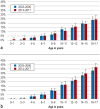Prevalence and Time Trends in Myopia Among Children and Adolescents
- PMID: 33612155
- PMCID: PMC8025934
- DOI: 10.3238/arztebl.2020.0855
Prevalence and Time Trends in Myopia Among Children and Adolescents
Abstract
Background: Myopia (near-sightedness) is increasing worldwide, especially in Asia. The aim of this study was to describe trends in the prevalence of myopia in Germany.
Methods: We analyzed data from the German Health Interview and Examination Survey for Children and Adolescents (KiGGS; baseline survey 2003-2006, N = 17 640; wave 2, 2014-2017, N = 15 023). The presence of myopia was determined from a parent questionnaire and validated by the use of a visual aid. The population prevalence of myopia was calculated. Based on the KiGGS wave 2 data, potential risk factors for myopia were identified by means of logistic regression.
Results: The prevalence of myopia at the age of 0-17 years in Germany was 11.6% (95% confidence interval [11.0; 12.2]) in the period 2003-2006 and 11.4% [10.7; 12.2] in 2014-2017. No age group of either sex exhibited a relevant, statistically significant change in the prevalence of myopia. In the adjusted model (adjusted for age, sex, family socioeconomic status, family history of migration), no association was found between myopia and use of digital media. More time spent reading books was associated with myopia: reading for more than 2 h/day showed an odds ratio of 1.69 [1.3; 2.2].
Conclusion: The prevalence of myopia in children and adolescents in Germany has remained virtually unchanged over a period of approximately 10 years. Changes in media consumption, such as the increased use of smartphones in this age group, have therefore had no detectable impact on the development of myopia, at least not so far. Future studies should investigate the influences of further increases in media use and examine the long-term effects.
Figures


Comment in
-
Approach Not Very Valid.Dtsch Arztebl Int. 2021 Apr 30;118(17):302. doi: 10.3238/arztebl.m2021.0137. Dtsch Arztebl Int. 2021. PMID: 34180802 Free PMC article. No abstract available.
References
-
- Bourne RR, Jonas JB, Flaxman SR, et al. Prevalence and causes of vision loss in high-income countries and in Eastern and Central Europe: 1990-2010. Br J Ophthalmol. 2014;98:629–638. - PubMed
-
- Herrnheiser J. Verlag von Fischer‘s Medic. Berlin: 1892. Die Refractionsentwicklung des menschlichen Auges.
-
- Mirshahi A, Ponto KA, Hoehn R, et al. Myopia and level of education: results from the Gutenberg Health Study. Ophthalmology. 2014;121:2047–2052. - PubMed
MeSH terms
LinkOut - more resources
Full Text Sources

